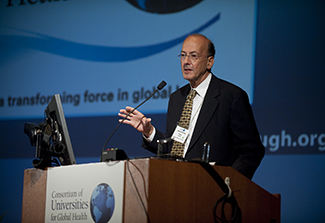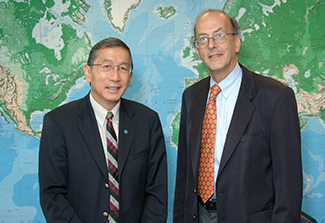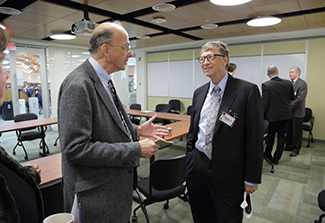The extraordinary career of Dr. Roger I. Glass
January/ February 2023 | Volume 22 Number 1
 Photo credit: Fogarty International CenterDr. Roger Glass addresses the annual meeting of the Consortium of Universities for Global Health, established in 2008.
Photo credit: Fogarty International CenterDr. Roger Glass addresses the annual meeting of the Consortium of Universities for Global Health, established in 2008.
On January 14, 2023, Dr. Roger I. Glass transitioned to senior scientist emeritus from his position as the longest-serving director of Fogarty International Center and associate director for international research at the National Institutes of Health. During his tenure, global health at NIH and on university campuses throughout the world has changed in visible and measurable ways. Fogarty was part of this change. Global health in the 20th century was grounded in infectious diseases and tropical medicine with smaller investments in maternal, neonatal and child health (MNCH), cancer, and other chronic diseases. Until the funding for HIV/AIDS grew, few of NIH’s 27 institutes and centers (ICs) had substantial interest or investments in the diseases and health problems effecting people in low- and middle-income countries (LMICs).
In the U.S., interest in global health practice and research grew out of the
PEPFAR program (the United States President's Emergency Plan for AIDS Relief), the U.S. government’s largest investment to date in global health with funds provided to support treatment and prevention of HIV/AIDS. PEPFAR was advanced by the president not only to prevent enormous loss of millions of lives in LMICs from universally fatal disease but for our own security, to prevent the chaos that might occur in these countries when millions of middle-aged people, leaders, teachers, health professionals and businesspeople succumbed to this then-untreatable infection.
Fogarty seized this opportunity, using the platform of PEPFAR to expand training of physicians and health personnel in LMICs to areas beyond HIV/AIDS. Fogarty engaged all 27 institutes and centers of NIH in its programs; today just under 90% of its grants receive co-funding from another IC. Furthermore, over the past 20 years, the Fogarty Global Health Fellows and Scholars Program, renamed LAUNCH, has provided research training for more than 1,400 students and fellows in the health sciences, both U.S. and foreign, in a wide variety of topics to start them on a pathway that might lead to productive careers in global health research. The AIDS International Training and Research Program (AITRP) trained more than 5,000 foreign scientists with masters and doctoral degrees and experiential training in clinical research and trials.
Dr. Glass explained: “I spoke with directors of each NIH institute about diseases in their portfolios that might be best studied abroad in LMIC populations, areas where the population experienced unusual exposures to infections, environmental pollution, or genetic background or where their conditions could be better studied due to issues in the delivery of care. I was suggesting to them that they ‘take their science to where the diseases were,’ the easiest way being to invest in a fellow in their field who was passionate about research and could benefit from mentors both at home and in the LMICs.
This formula proved irresistible. We recruited cardiologists, oncologists, surgeons, neuroscientist, dermatologists and dentists, geneticists, data scientist, bioengineers. Their diversity was extraordinary, their passion unstoppable, and their creativity gratifying. Many of these fellows will be the seeds for growing global health research in the 21st century. Instead of simply asking for financial support for programs of interest to Fogarty, the ICs were investing in their own future global workforce of both U.S. and foreign investigators, selected by peer review for unique topics and outstanding training and commitment. After 17 years, many ICs have developed their own researchers who have built global health research programs in the universities where they trained, and in their professional associations. The future of research in global health will grow from the careers of these young fellows, these investigators rising through the academic pathway.”
The Journey
Dr. Glass’s career as an epidemiologist began when he joined the Epidemic Intelligence Service (EIS) at the CDC (U.S. Centers for Disease Control and Prevention). “I did 12 epidemic investigations, one after another—snowstorm deaths; Native American railroad employees dying in the heat of Texas; fishermen dying in the hulls of their ships; low sperm counts among Chicano pesticide workers. They were all fascinating, all sparked my curiosity, and all were published.”
Wanting to travel, Dr. Glass accepted an appointment to the International Center for Diarrhoeal Disease Research in Bangladesh (icddr,b) in 1979. “By serendipity, Jan Holmgren, who made the oral vaccine for cholera, lodged in the same guest house and for three and a half years, we worked together closely on cholera and rotavirus. He said the work I’d done on cholera would be suitable for a Ph.D. in Sweden, so I went to the University of Gothenburg and, over a period of nine months, I wrote up eight papers on the epidemiology of cholera and defended my thesis.”
Next, Dr. Glass joined the NIH’s laboratory of infectious diseases. “I spent three years focusing on the molecular biology of rotavirus with Dr. Al Kapickian, who made the first rotavirus vaccine. He taught me laboratory methods of molecular virology and sequencing.” Needing to grow, Dr. Glass returned to CDC as chief of the viral gastroenteritis unit at the National Center for Infectious Diseases. “I stayed for 20 years and trained 25 to 30 EIS officers, and a larger number of laboratory scientists from around the world to work with rotavirus and other enteric viruses.”
Averting early deaths
“My years in Bangladesh underscored the devastating impact diarrhea had on children under 5,” observed Dr. Glass. WHO estimated that in 2013 alone, rotaviruses, the most common cause of severe diarrheal disease in infants and young children worldwide, caused about 215,000 deaths, predominantly in developing countries. Over three decades, Dr. Glass conducted field studies in India, Bangladesh, Brazil, Mexico, Israel, Russia, Vietnam, and China, documenting the epidemiology and enormous global burden of rotavirus. He also helped develop vaccines (and the protocols for their use) to prevent disease.
 Photo credit: Fogarty International CenterDr. Tikki Pang (left), WHO's Director of Research Policy at the time, and Dr. Glass (right) in 2007.
Photo credit: Fogarty International CenterDr. Tikki Pang (left), WHO's Director of Research Policy at the time, and Dr. Glass (right) in 2007.
His exhaustive efforts paid substantial public health dividends. Today, more than 120 national immunization programs include rotavirus vaccines, significantly reducing diarrheal hospitalizations and deaths and improving the health of millions of children worldwide.
Focus on neglected populations
Dr. Glass joined Fogarty as director on March 31, 2006. During his 17-year tenure, he steered the center toward building partnerships between U.S. and lower resource country institutions, while supporting the career development of global health researchers and leaders at home and abroad. Researchers trained by Fogarty have enhanced global security through their involvement and leadership in response to the epidemics of HIV, Ebola, Zika and COVID-19.
As NIH’s associate director for international research, Dr. Glass established a productive collaboration with Dr. Francis Collins, then director of NIH. Together they partnered with PEPFAR to develop the
Medical Education Partnership Initiative in Africa, helped launch the Consortium of Universities for Global Health, assisted NIH in joining the Global Alliance for Chronic Diseases, and, through the NIH Common Fund, supported both the
Human Heredity and Health in Africa and the
Harnessing Data Science for Health Discovery and Innovation in Africa (DS-I Africa) programs. Dr. Glass helped bring Bill Gates to campus to deliver the David E. Barmes Global Health Lecture, which led to annual partnership activities between the philanthropist’s own organization and NIH.
 Photo credit: Fogarty International CenterDr Glass (left) speaks informally with Bill Gates (right), founder of Microsoft and the Gates Foundation
Photo credit: Fogarty International CenterDr Glass (left) speaks informally with Bill Gates (right), founder of Microsoft and the Gates Foundation
Over the course of his career, Dr. Glass also worked at Mount Sinai Health System in New York City, Oxford University, the Sysin Institute in Moscow, and the WHO in Geneva. He has co-authored more than 600 papers and chapters. Along the way, he became fluent in French, Spanish, Portuguese, and Russian. Among his many honors, Dr. Glass received the 2015 Albert B. Sabin Gold Medal Award from the Sabin Vaccine Institute, and was inducted into the National Academy of Medicine. As an emeritus scientist, he hopes to expand engagement in global health, bolster equity and diversity in Fogarty programs, and support existing partnerships. He also plans to spend more time with his wife, Dr. Barbara Stoll, and his three children: Nina, Michael and Andy Glass.
“Being the director of Fogarty was an absolute joy; it is surely one of the best positions to support the training of future researchers and leaders in global health research. I sometimes feel that in my years at NIH and CDC, I never worked a day in my life.”
Updated February 15, 2023
To view Adobe PDF files,
download current, free accessible plug-ins from Adobe's website.